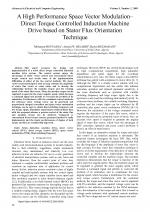| 2/2009 - 5 |
A High Performance Space Vector Modulation - Direct Torque Controlled Induction Machine Drive based on Stator Flux Orientation TechniqueBOUNADJA, M. |
| View the paper record and citations in |
| Click to see author's profile in |
| Download PDF |
Author keywords
Induction machine drive, stator vector control (SVC), direct torque control (DTC), space vector modulation (SVM), fixed switching frequency
References keywords
control(17), torque(10), induction(9), direct(9), motor(6), drives(6), power(5)
Blue keywords are present in both the references section and the paper title.
About this article
Date of Publication: 2009-06-02
Volume 9, Issue 2, Year 2009, On page(s): 28 - 33
ISSN: 1582-7445, e-ISSN: 1844-7600
Digital Object Identifier: 10.4316/AECE.2009.02005
Web of Science Accession Number: 000268723600005
SCOPUS ID: 70349164317
Abstract
This paper proposes the design and implementation of a novel direct torque controlled induction machine drive system. The control system enjoys the advantages of stator vector control and conventional direct torque control and avoids some of the implementation difficulties of either of the two control methods. The stator vector control principal is used to keep constant the amplitude of stator flux vector at rated value, and to develop the relationship between the machine torque and the rotating speed of the stator flux vector. Thus, the machine torque can be regulated to generate the stator angular speed, which becomes a command signal and permits to overcome the problem of its estimation. Furthermore, with the combined control methods, the reference stator voltage vector can be generated and proportional-integral controllers and space vector modulation technique can be used to obtain fixed switching frequency and low torque ripple. Simulation experiments results indicate that, with the proposed scheme, a precise control of the stator flux and machine torque can be achieved. Compared to conventional direct torque control, presented method is easily implemented, and the steady performances of ripples of both torque and flux are considerably improved. |
| References | | | Cited By |
Web of Science® Times Cited: 6 [View]
View record in Web of Science® [View]
View Related Records® [View]
Updated 4 days, 16 hours ago
SCOPUS® Times Cited: 7
View record in SCOPUS® [Free preview]
View citations in SCOPUS® [Free preview]
[1] Sensorless direct torque control based on nonlinear integral sliding mode controllers for an induction motor drive: Experimental verification, Krim, Saber, Krim, Youssef, Mimouni, Mohamed Faouzi, Proceedings of the Institution of Mechanical Engineers, Part I: Journal of Systems and Control Engineering, ISSN 0959-6518, Issue 2, Volume 235, 2021.
Digital Object Identifier: 10.1177/0959651820933733 [CrossRef]
[2] Experimental Study and Comparative Analysis of Transients of Induction Motor with Soft Starter Startup, DEACONU, S. I., TOPOR, M., POPA, G. N., BISTRIAN, D., Advances in Electrical and Computer Engineering, ISSN 1582-7445, Issue 3, Volume 10, 2010.
Digital Object Identifier: 10.4316/aece.2010.03005 [CrossRef] [Full text]
[3] Second-order Sliding-mode Control Approaches to Improve Low-speed Operation of Induction Machine under Direct Torque Control, Ben Salem, Fatima, Derbel, Nabil, Electric Power Components and Systems, ISSN 1532-5008, Issue 17, Volume 44, 2016.
Digital Object Identifier: 10.1080/15325008.2016.1199069 [CrossRef]
[4] Speed Regulated Continuous DTC Induction Motor Drive in Field Weakening, MATIC, P., VUKOSAVIC, S. N., Advances in Electrical and Computer Engineering, ISSN 1582-7445, Issue 1, Volume 11, 2011.
Digital Object Identifier: 10.4316/AECE.2011.01016 [CrossRef] [Full text]
[5] Analysis of Torque Ripple Reduction in Induction Motor DTC Drive with Multiple Voltage Vectors, ROSIC, M. M., BEBIC, M. Z., Advances in Electrical and Computer Engineering, ISSN 1582-7445, Issue 1, Volume 15, 2015.
Digital Object Identifier: 10.4316/AECE.2015.01015 [CrossRef] [Full text]
Disclaimer: All information displayed above was retrieved by using remote connections to respective databases. For the best user experience, we update all data by using background processes, and use caches in order to reduce the load on the servers we retrieve the information from. As we have no control on the availability of the database servers and sometimes the Internet connectivity may be affected, we do not guarantee the information is correct or complete. For the most accurate data, please always consult the database sites directly. Some external links require authentication or an institutional subscription.
Web of Science® is a registered trademark of Clarivate Analytics, Scopus® is a registered trademark of Elsevier B.V., other product names, company names, brand names, trademarks and logos are the property of their respective owners.
Faculty of Electrical Engineering and Computer Science
Stefan cel Mare University of Suceava, Romania
All rights reserved: Advances in Electrical and Computer Engineering is a registered trademark of the Stefan cel Mare University of Suceava. No part of this publication may be reproduced, stored in a retrieval system, photocopied, recorded or archived, without the written permission from the Editor. When authors submit their papers for publication, they agree that the copyright for their article be transferred to the Faculty of Electrical Engineering and Computer Science, Stefan cel Mare University of Suceava, Romania, if and only if the articles are accepted for publication. The copyright covers the exclusive rights to reproduce and distribute the article, including reprints and translations.
Permission for other use: The copyright owner's consent does not extend to copying for general distribution, for promotion, for creating new works, or for resale. Specific written permission must be obtained from the Editor for such copying. Direct linking to files hosted on this website is strictly prohibited.
Disclaimer: Whilst every effort is made by the publishers and editorial board to see that no inaccurate or misleading data, opinions or statements appear in this journal, they wish to make it clear that all information and opinions formulated in the articles, as well as linguistic accuracy, are the sole responsibility of the author.





